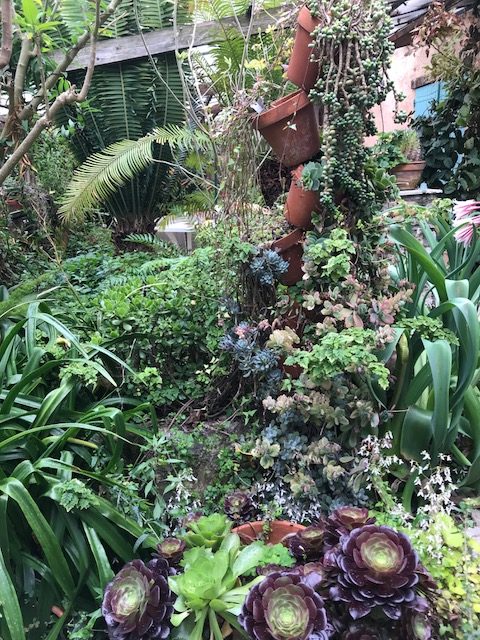May / mai 2019
A visit to gardens in Vallauris and Cagnes-sur-Mer
Click on an image to enlarge it / Cliquez sur une image pour l’agrandir
On May 21st we visited two very interesting gardens – each one had been given a very personal touch by the owners.
Madame Zanini’s garden in Vallauris
In the morning we met at the entrance of a very special garden, owned by Madame Zanini. She and her husband moved to the property when they retired in 1998, when it was a citrus farm. The couple decided to cut down all the 78 lemon trees that had previously been exploited commercially and turn the restanques into a garden. Before retiring, the Zaninis had grown vegetables but never had a personal garden, because of lack of time.
Evidently, their plant knowledge, although downplayed by Madame, must have served them to develop the extraordinary garden we visited. From the moment we entered the property, everywhere we looked, there were unusual species of plants. Every square metre was occupied with wonderfully lush-looking specimens of all kinds and types: hydrangea climbing up the wall of the house at the entrance, Thunbergia grandiflora on the north wall, Cestrum nocturnum, blue solanum, ficus, euphorbias, Juanulloa mexicana, a Mahonia x media ‘Charity’… As we entered the courtyard a huge display of potplants, including a collection of geraniums from the Canaries, Madeira and Africa, were blooming prolifically. As we walked further into the garden, we discovered several terraces with a large variety of pot plants, all thriving.
Madame told us that until a couple of years ago, she had 150 different types of geranium, but over time she had given many away to friends and family.
As we walked along small paths and took steps up and down the garden, the plants kept coming – brachychitons of impressive size, including B. acerifolius, Erythrina lysistemon, different types of callistemon, Senna didymobotrya (syn. Cassia didymobotrya) smelling of peanut, a huge Persea americana going around the wall and up and down the garden, with mini, gherkin-sized avocados, and another avocado tree, P. americana var. ‘Hass’. Then it continued with Stenocarpus sinuatus, Hardenbergia violacea (syn. H. monophyla), wonderful strelitzias in flower, a Petrea volubilis and many, many more plants. In addition, we noticed one or two greenhouses, packed with cacti and succulents.
Underneath the huge trees and plants were many different, smaller plants and ground cover. At the time of our visit the Freesia laxa (red and white) were in flower. Several of the visitors were generously offered some small plants to take home. The climate of the property, close to the coast, means that there is little to no frost and relatively high humidity in summer. The soil in the garden is rich, black and deep, and holds moisture well, a legacy from the lemon tree days.
This microclimate contributes to the rapid growth of the various plants and trees in the garden. However, without the couple’s dedication and love for plants, this garden would not be what it is today. Madame didn’t want to let us go until we tasted her limoncello, home-made from different citrus fruits. Excellent indeed! Certainly, a visit to be remembered!
The Marro garden in Cagnes-sur-Mer
Most of us continued to the next garden, the Marro garden in Cagnes-sur-Mer, owned by Jean-Paul Spinetta. This was a totally different experience. After enjoying our picnic lunch under the trees, we were taken on a tour by the passionate owner of the property. We were presented with a small movie, showing how the family had lived on the same property since 1928. At that time the property lay in productive farming countryside, but now it is surrounded by buildings, with the railway line and motorway close by.
Produce used to be grown here, and in order to ensure there was access to irrigation, the fields were edged and crossed by man-made water channels, taking water from local streams and natural springs. At weekly intervals, water distribution took place to each of the fields. A very clever system indeed. Unfortunately, much of the water channel system in the area is now out of use, but on this property, as demonstrated to us by the owners, the channels and two springs are still working perfectly. We were also shown examples of tools, used by the family in the past to work the fields.
Next we visited different parts of the garden and at each stop were given useful tips. We were shown examples of two trees next to each other– one growing strongly, a different species not doing well, “simply because they don’t like each other, I shouldn’t have planted them together”, the owner explained. Indeed, we saw, in another spot in the garden, the same species of tree doing very well. We noticed that the owners had hung broken eggshells in small nets in the trees, to minimize aphid infestation. After the visit I tried this trick myself at home, and yes, it does reduce the number of aphids. They explained to us that santolinas help to reduce infestations by ants. This year on our property they are everywhere – I wish I had planted more santolinas!
And the tips kept coming: how marigolds (Calendula officinalis) help reduce parasites in fruit trees and in the vegetable garden, how citrus skin does the same for roses, how to increase magnesium levels in the soil by burying banana skins. We then visited the rose garden, saw olive trees and a plantation of different grape varieties. The owner still manually presses his own grapes and olives to make wine and olive oil.
This garden of treasures merits preservation in the middle of galloping urbanization. It receives visits from locals and from school children who, we were told, are inspired by what they see. A great initiative.
Text and photographs: Jacqueline Potter
![]()







